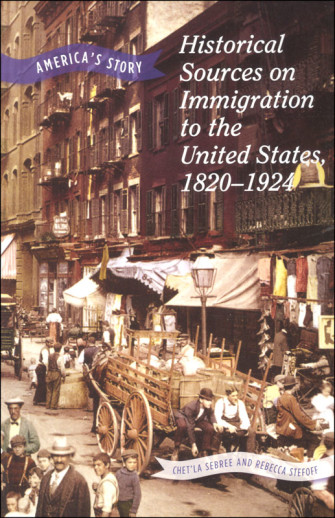We use cookies to make your experience better. To comply with the new e-Privacy directive, we need to ask for your consent to set the cookies. Learn more.
Historical Sources on Immigration to the United States: 1820-1924 (America's Story)
The personal historical sources in this book of America's Story give interest to stories of passengers from different countries and their travel to America, life after the voyage once settled, and details regarding what is known as the “Melting Pot". Additional topics also include immigration and naturalization, emigration, and the process known as Americanization.
Between the nineteenth and early twentieth centuries, nearly forty million people immigrated to the United States. Poverty, widespread famine, and the California gold rush prompted many people to leave their home countries for America. Over time, however, the government tried to slow the flow of immigration with laws like the Johnson-Reed Act in 1924. In this book, students will read accounts from immigrants about the decision to leave home, the journey to America, and life in the new world. Additionally, students will read about xenophobic responses to immigration from the descendants of colonists. Through primary sources, this book provides students with an in-depth understanding of immigration to the United States.
America's Story is a series of books covering various US history topics geared toward upper-level students. Each paperback book is approximately 144 pages long containing snippets of historical sources such as letters, newspaper articles, and interspersed with author narrative, pictures, key terms and concepts, chronology, and comprehension questions. There is also a glossary, a "further information" section with suggestions of books, websites, videos etc. and an index in each book. While each book is written chronologically within itself, the series does not definitively move in chronological order from one book to the next. Each book begins with a couple of pages about primary source documents and how to read them, then adds an introduction to the topic of the book before moving into the chapters. It seems to me that the approach of these books evaluates historical topics from a more detailed account and personal level of the state of humanity at the time. This could allow students an easier ability to step back in time and interpret history using their own diverse perspectives of the world as they know it today. Although these books are designated for middle and high school ages, the language outside of some of the sources is not difficult to read or comprehend. The application of these books could vary in one's homeschool, perhaps allowing for more in-depth study of certain topics of interest, research, or filling in missing topics in core curriculum. They are easy to read, frequented with illustrated pictures, thought provoking "Consider this" questions, and tidbits of interesting information, like medicinal treatments. ~Judy
| Product Format: | Paperback |
|---|---|
| Grades: | 8-12 |
| Brand: | Cavendish Square |
| ISBN: | 9781502640802 |
| Length in Inches: | 9 |
| Width in Inches: | 5.875 |
| Height in Inches: | 0.3125 |
| Weight in Pounds: | 0.65 |
Be the first to review this item

